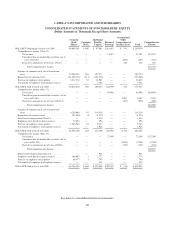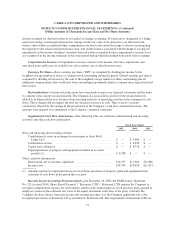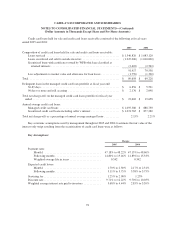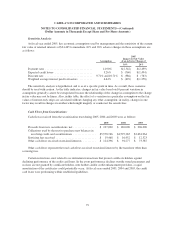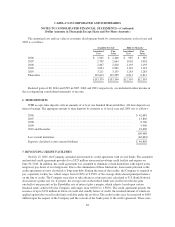Cabela's 2005 Annual Report Download - page 88
Download and view the complete annual report
Please find page 88 of the 2005 Cabela's annual report below. You can navigate through the pages in the report by either clicking on the pages listed below, or by using the keyword search tool below to find specific information within the annual report.CABELA’S INCORPORATED AND SUBSIDIARIES
NOTES TO CONSOLIDATED FINANCIAL STATEMENTS—(Continued)
(Dollar Amounts in Thousands Except Share and Per Share Amounts)
effective for the Company beginning January 1, 2006. Under the Modified Prospective Method, the Company
will recognize compensation expense for equity awards issued after January 1, 2006 on a straight-line basis over
the requisite service period for the entire award. The Company also expects to record expense of approximately
$2.3 million in fiscal 2006 and $1.5 million in fiscal 2007 related to previously-issued, unvested and outstanding
stock options that were granted after the Company’s first public filing. The Company will continue to utilize the
Black Scholes model in calculating estimated fair value of stock options. On March 29, 2005, the SEC issued
Staff Accounting Bulletin No. 107 (“SAB 107”). SAB 107 provides interpretations expressing the views of the
SEC staff regarding the interaction between Statement 123R and certain SEC rules and regulations, and provides
the staff’s views regarding the valuation of share-based payment arrangements for public companies. SAB 107
does not modify any of the conclusions or requirements of Statement 123R. On November 10, 2005, the FASB
issued FSP FAS 123R-3 which “Provides a Transition Election for Calculating the APIC Pool Under Statement
123R.” Statement 123R APIC Pool—Statement 123R requires companies to calculate the pool of excess tax
benefits available to absorb tax deficiencies recognized subsequent to the adoption of Statement 123R (the
“APIC pool”). In calculating the APIC pool, a company must include the net excess tax benefits as if the
company originally adopted Statement 123 for recognition purposes. Many companies have indicated that they
do not have, and may not be able to re-create, such information. Accordingly, the FASB issued FSP FAS 123R-3
to provide an elective transition alternative to calculating the APIC pool. A company may take up to one year
from the later of its initial adoption of Statement 123R or November 11, 2005, to make its election. The
Company is currently evaluating the transition method for calculating the APIC Pool.
On May 30, 2005, the FASB issued Statement 154, “Change in Accounting Principle” (“Statement 154”),
which changes the requirements for the accounting and reporting of a change in accounting principle. Statement
154 applies to all voluntary changes in accounting principle as well as to changes required by an accounting
pronouncement that does not include specific transition provisions. Statement 154 eliminates the requirement in
APB Opinion No. 20, Accounting Changes, to include the cumulative effect of changes in accounting principle in
the income statement in the period of changes. Instead, to enhance the comparability of prior period financial
statements, Statement 154 requires that changes in accounting principle to be retrospectively applied. Under
retrospective application, the new accounting principle is applied as of the beginning of the first period presented
as if that principle had always been used. The cumulative effect of the change is reflected in the carrying value of
assets and liabilities as of the first period presented and the offsetting adjustments are recorded to opening
retained earnings. Each period presented is adjusted to reflect the period-specific effects of applying the changes.
Statement 154 is effective for accounting changes and corrections of errors made in fiscal years beginning after
December 15, 2005. The Company does not believe the adoption of Statement 154 will have a material impact on
its financial statements.
On July 14, 2005, the FASB published an exposure draft entitled “Accounting for Uncertain Tax
Positions—an interpretation of FASB Statement No. 109” (“the proposed interpretation”). The proposed
interpretation is intended to reduce the significant diversity in practice associated with recognition and
measurement of income taxes by establishing consistent criteria for evaluating uncertain tax positions. The
proposed interpretation establishes a probable recognition threshold. To recognize a benefit from a tax position, a
company must conclude that the position is probable of being sustained upon audit based solely on the technical
merits of the position. Once the probable recognition threshold is met, the best estimate of the amount that would
be sustained on audit should be recognized. In the period in which it becomes more likely than not that a tax
position would no longer be sustained upon an audit by a taxing authority, the benefit should be derecognized by
recording an income tax liability or reducing a deferred tax asset. A liability arising from the difference between
the position taken in the tax return and the amount booked in the financial statements pursuant to the proposed
interpretation should be classified as a current liability if expected to be paid within one year. However, if the
liability arises from a taxable temporary difference, it would be classified as a deferred tax liability. Companies
76


